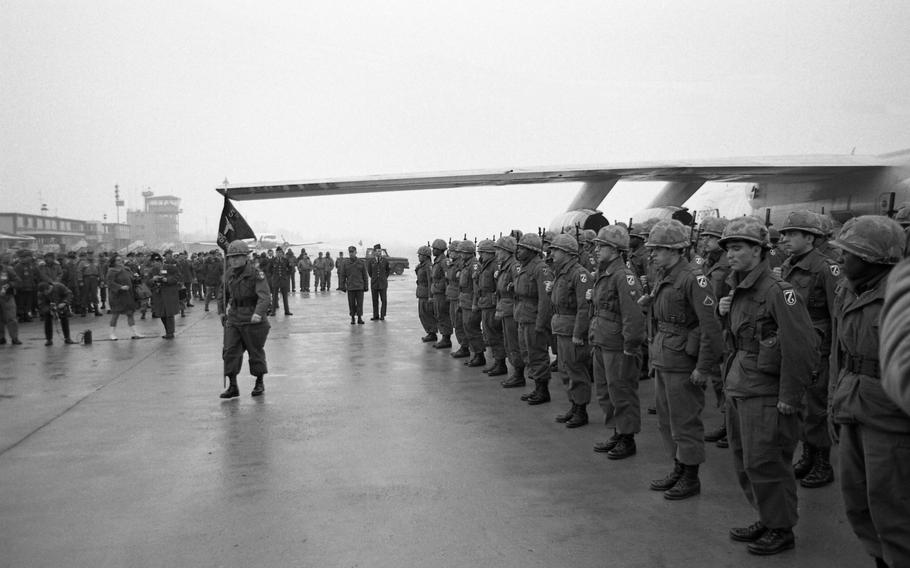
Troops from the 5th Surgical Hospital stationed in Ft. Knox, Kentucky stand in formation. Maj. Callie Carson — the only woman involved in Reforger I — was the chief nurse of the 5th. (Joe Wesley/Stars and Stripes)
This article first appeared in Stars and Stripes’ Europe edition Jan. 21, 1969. It is republished unedited in its original form.
NUERNBERG, Germany — Despite bad weather, Reforger I’s debut in Nuernberg was a spectacular show of timing and coordination, seemingly without opening-day jitters.
The show began early Monday with a brass-band review for the first arrivals. There were speeches and handshakes.
The show opened when the 5th Surgical Hospital from Ft. Knox, Ky., marched out of the first swoop-winged C141 StarLifter — the workhorse heavy in this production.
Maj. Callie Carson, the hospital’s chief nurse, is the only woman involved in Reforger I.
She and Capt. Robert Turman, hospital commander, led their units, dressed in pressed fatigues and bright scarves, behind a flowing guidon.
More than 70 newsmen from many nations, including Spain, Italy, Holland, Japan and the United States, hurried around, snapping cameras and gathering interviews.
About 200 Germans watched the show. Cars lined the incoming roads, creating a mild traffic bottleneck at the airport.
Scene two wasn’t as grand, but there was still a brass band. The 4th Armd. Div. band greeted the second aircraft to land, which contained the first of the 24th Inf. Div. units to arrive.
The troops marched out of the StarLifter with gas masks, packs and rifles on their shoulders. They climbed into trucks and were shuttled to a railway pick-up point, where they left for Grafenwoehr.
Meanwhile, it was curtains for Rhein-Main Air Base, when weather conditions prevented the big jets from landing. It was previously planned that the C141s would drop the troops in Nuernberg. Then every other flight would go to Rhein-Main or Fuerstenfeldbruck in Munich.
The planes were to refuel, change crews and roar back to the United States. But a ceiling of 200 feet and a visibility of less than half a mile ended the airport’s role in Reforger I.
Brig. Gen. Hugh E. Wild, senior commander of the European Airlift Control Element, said that the increased air traffic to Fuerstenfeldbruck would not disturb the airlift.
At Camp Aachen in the Grafenwoehr training area, vehicles and barracks are ready for the 5,000 Reforger I troops who will be brought here during the 36-hour airlift operation.
M. Sgt. Gerald Hostetler, operations sergeant for the 2nd Brigade of the 24th Inf. Div. and a veteran of Operation Big Lift in 1963, was impressed with the flow of traffic through Nuernberg.
As the sergeant climbed into the back of a truck, he said, “This operation is smoother and seemingly more organized. It’s a relief not to have to sit around and wait for hours. The layover at McGuire Air Force Base was only three hours.
Want to read other articles about Reforger I and all subsequent Reforgers? Subscribe to Stars and Stripes’ historic newspaper archive. We have digitized our 1948-1999 European and Pacific editions, as well as several of our WWII editions and made them available online through https://starsandstripes.newspaperarchive.com/